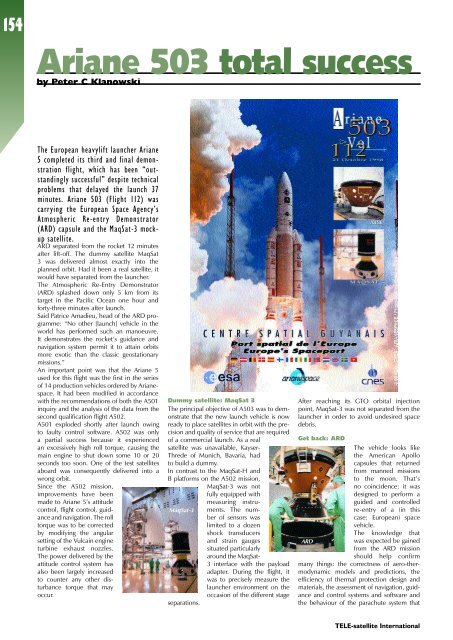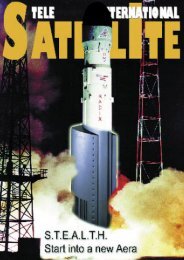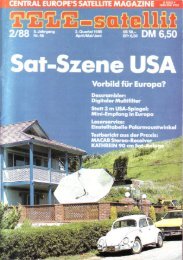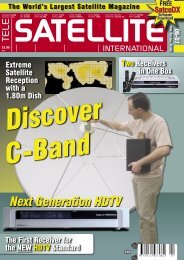Bestellen Sie diesen Satelliten- Newsletter! - TELE-satellite ...
Bestellen Sie diesen Satelliten- Newsletter! - TELE-satellite ...
Bestellen Sie diesen Satelliten- Newsletter! - TELE-satellite ...
You also want an ePaper? Increase the reach of your titles
YUMPU automatically turns print PDFs into web optimized ePapers that Google loves.
154<br />
Ariane 503 total success<br />
by Peter C Klanowski<br />
The European heavylift launcher Ariane<br />
5 completed its third and final demonstration<br />
flight, which has been “outstandingly<br />
successful” despite technical<br />
problems that delayed the launch 37<br />
minutes. Ariane 503 (Flight 112) was<br />
carrying the European Space Agency’s<br />
Atmospheric Re-entry Demonstrator<br />
(ARD) capsule and the MaqSat-3 mockup<br />
<strong>satellite</strong>.<br />
ARD separated from the rocket 12 minutes<br />
after lift-off. The dummy <strong>satellite</strong> MaqSat<br />
3 was delivered almost exactly into the<br />
planned orbit. Had it been a real <strong>satellite</strong>, it<br />
would have separated from the launcher.<br />
The Atmospheric Re-Entry Demonstrator<br />
(ARD) splashed down only 5 km from its<br />
target in the Pacific Ocean one hour and<br />
forty-three minutes after launch.<br />
Said Patrice Amadieu, head of the ARD programme:<br />
“No other [launch] vehicle in the<br />
world has performed such an manoeuvre.<br />
It demonstrates the rocket’s guidance and<br />
navigation system permit it to attain orbits<br />
more exotic than the classic geostationary<br />
missions.”<br />
An important point was that the Ariane 5<br />
used for this flight was the first in the series<br />
of 14 production vehicles ordered by Arianespace.<br />
It had been modified in accordance<br />
with the recommendations of both the A501<br />
inquiry and the analysis of the data from the<br />
second qualification flight A502.<br />
A501 exploded shortly after launch owing<br />
to faulty control software. A502 was only<br />
a partial success because it experienced<br />
an excessively high roll torque, causing the<br />
main engine to shut down some 10 or 20<br />
seconds too soon. One of the test <strong>satellite</strong>s<br />
aboard was consequently delivered into a<br />
wrong orbit.<br />
Since the A502 mission,<br />
improvements have been<br />
made to Ariane 5’s attitude<br />
control, flight control, guidance<br />
and navigation. The roll<br />
torque was to be corrected<br />
by modifying the angular<br />
setting of the Vulcain engine<br />
turbine exhaust nozzles.<br />
The power delivered by the<br />
attitude control system has<br />
also been largely increased<br />
to counter any other disturbance<br />
torque that may<br />
occur.<br />
Dummy <strong>satellite</strong>: MaqSat 3<br />
The principal objective of A503 was to demonstrate<br />
that the new launch vehicle is now<br />
ready to place <strong>satellite</strong>s in orbit with the precision<br />
and quality of service that are required<br />
of a commercial launch. As a real<br />
<strong>satellite</strong> was unavailable, Kayser-<br />
Threde of Munich, Bavaria, had<br />
to build a dummy.<br />
In contrast to the MaqSat-H and<br />
B platforms on the A502 mission,<br />
MaqSat-3 was not<br />
fully equipped with<br />
measuring instru-<br />
MaqSat-3 ments. The number<br />
of sensors was<br />
limited to a dozen<br />
shock transducers<br />
and strain gauges<br />
situated particularly<br />
around the MaqSat-<br />
3 interface with the payload<br />
adapter. During the flight, it<br />
was to precisely measure the<br />
launcher environment on the<br />
occasion of the different stage<br />
separations.<br />
After reaching its GTO orbital injection<br />
point, MaqSat-3 was not separated from the<br />
launcher in order to avoid undesired space<br />
debris.<br />
Get back: ARD<br />
The vehicle looks like<br />
the American Apollo<br />
capsules that returned<br />
from manned missions<br />
to the moon. That’s<br />
no coincidence: it was<br />
designed to perform a<br />
guided and controlled<br />
re-entry of a (in this<br />
case: European) space<br />
vehicle.<br />
The knowledge that<br />
ARD<br />
was expected be gained<br />
from the ARD mission<br />
should help confirm<br />
many things: the correctness of aero-thermodynamic<br />
models and predictions, the<br />
efficiency of thermal protection design and<br />
materials, the assessment of navigation, guidance<br />
and control systems and software and<br />
the behaviour of the parachute system that<br />
<strong>TELE</strong>-<strong>satellite</strong> International











